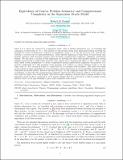Equivalence of Convex Problem Geometry and Computational Complexity in the Separation Oracle Model
Author(s)
Vera Andreo, Jorge R.; Freund, Robert Michael
DownloadFreund_Equivalent of Convex.pdf (269.8Kb)
OPEN_ACCESS_POLICY
Open Access Policy
Creative Commons Attribution-Noncommercial-Share Alike
Terms of use
Metadata
Show full item recordAbstract
Consider the supposedly simple problem of computing a point in a convex set that is conveyed by a separation oracle with no further information (e.g., no domain ball containing or intersecting the set, etc.). The authors' interest in this problem stems from fundamental issues involving the interplay of (i) the computational complexity of computing a point in the set, (ii) the geometry of the set, and (iii) the stability or conditioning of the set under perturbation. Under suitable definitions of these terms, the authors show herein that problem instances with favorable geometry have favorable computational complexity, validating conventional wisdom. The authors also show a converse of this implication by showing that there exist problem instances that require more computational effort to solve in certain families characterized by unfavorable geometry. This in turn leads, under certain assumptions, to a form of equivalence among computational complexity, geometry, and the conditioning of the set. The authors' measures of the geometry, relative to a given reference point, are based on the radius of a certain domain ball whose intersection with the set contains a certain inscribed ball.The geometry of the set is then measured by the radius of the domain ball, the radius of the inscribed ball, and the ratio between these two radii, the latter of which is called the aspect ratio. The aspect ratio arises in the analysis of many algorithms for convex problems, and its importance in convex algorithm analysis has been well-known for several decades. However, the presence in our bound of terms involving only the radius of the domain ball and only the radius of the inscribed ball are a bit counterintuitive; nevertheless, we show that the computational complexity must involve these terms in addition to the aspect ratio, even when the aspect ratio itself is small. This lower-bound complexity analysis relies on simple features of the separation oracle model; if we instead assume that the set is conveyed by a self-concordant barrier function, then it is an open challenge to prove such a complexity lower-bound.
Date issued
2009-03Department
Sloan School of ManagementJournal
Mathematics of Operations Research
Publisher
Institute for Operations Research and the Management Sciences (INFORMS)
Citation
Freund, Robert M, and Jorge R Vera. “Equivalence of Convex Problem Geometry and Computational Complexity in the Separation Oracle Model.” Mathematics of Operations Research 34.4 (2009): 869-879. © 2009 Institute for Operations Research and the Management Sciences.
Version: Author's final manuscript
ISSN
0364-765X
1526-5471